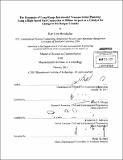The dynamics of long-range intermodal transportation planning : using a high-speed rail connection to Bilbao Airport as a catalyst for change in the Basque Country
Author(s)
Hernández, Kari Linn
DownloadFull printable version (15.45Mb)
Alternative title
Using a high-speed rail connection to Bilbao Airport as a catalyst for change in the Basque Country
Other Contributors
Massachusetts Institute of Technology. Dept. of Civil and Environmental Engineering.
Advisor
Mikel Murga and Frederick Salvucci.
Terms of use
Metadata
Show full item recordAbstract
The extension of the Spanish high-speed rail network into the Basque Country will connect the capital cities of the three Basque provinces, creating an opportunity to drive change at many levels of the transportation network and making the region more attractive to both internal and external business interests. Accordingly, accessibility improvements can drive economic growth, with particular benefit to traditionally "peripheral" regions from the point of view of air accessibility such as Donostia-San Sebastiin and Vitoria-Gasteiz. This thesis aims to identify how multimodal integration and decision timelines impact network characteristics that collectively make the region more accessible for business travel both originating in and destined for the Basque Country. The high-speed rail alone will improve accessibility to a few destinations, but a multimodal journey - provided there is a direct high-speed rail connection to Bilbao Airport - results in many sizeable activity centers becoming reachable within a critical timeframe important to business journeys. A system dynamics model captures the relationships between the various subsystems including the high-speed rail network, the urban transportation networks, and Bilbao Airport. The main contribution is to support decision-making that will prevent repeating historical mistakes in the area of intermodality. This approach helps to depict the synergistic nature of sequential decisions that can activate particular system feedback, resulting in compounded benefits. Due to the nonlinearity of complex systems driven by reinforcing and balancing feedback loops, prioritizing intermodality sooner than later will be much more impactful in the long term, leading to not only faster growth but stabilizing and higher levels of performance - creating a sustainably attractive landscape for business activity.
Description
Thesis (S.M. in Transportation)--Massachusetts Institute of Technology, Dept. of Civil and Environmental Engineering, 2011. Cataloged from PDF version of thesis. Includes bibliographical references (p. 129-131).
Date issued
2011Department
Massachusetts Institute of Technology. Department of Civil and Environmental EngineeringPublisher
Massachusetts Institute of Technology
Keywords
Civil and Environmental Engineering.